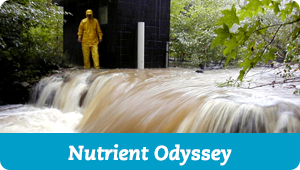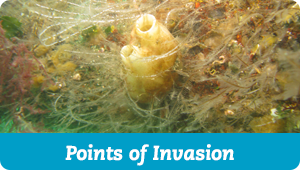Wetlands sustain life on the coasts, not only for plants and animals, but people as well. They offer young fish and crabs a place to hide from predators. Their soils filter out pollution like a sponge before it reaches the ocean. And they shield nearby homes from floods, hurricanes and other dangers that come with living near the water.
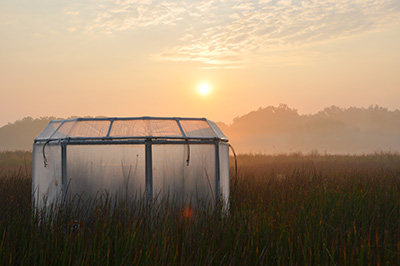
Experimental chamber where ecologists simulate the future in the Global Change Research Wetland. ©Tom Mozdzer.
But as climate changes, so do the wetlands. And with sea levels rising, they’re facing more and more pressure to build soil quickly enough to stay afloat.
Enter the Global Change Research Wetland, or “Marsh of the Future”, where scientists are fast-forwarding to the year 2100. Inside plastic chambers, Smithsonian ecologists like Pat Megonigal are injecting an extra 350 parts per million CO2 into the air, simulating what some estimates predict the atmosphere could contain a century from now. They’re adding more nitrogen to the soil, to reflect the stream of nutrients from further inland. They’re also artificially raising sea level to see how plants cope with flooded soils. In the process they’ve discovered not one outcome, but a mosaic of possible futures.
What happens if CO2 increases?
Most plants grow better in a world spiked with CO2. Most, but not all. The ones that undergo a growth spurt are generally C3 plants—a group that includes trees, sedges and 95 percent of all plant species. The other major group, C4 plants, includes the common marsh grass Spartina patens. C4 plants respond only weakly when CO2 levels rise. Life would still flourish under a CO2-rich atmosphere, but the marsh would probably be covered in more sedge than grass.
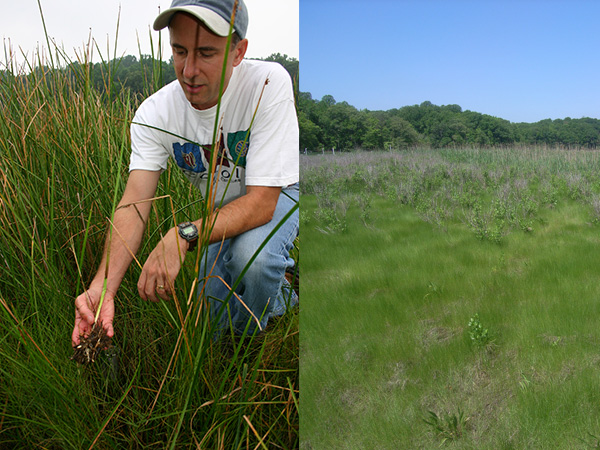
Left: The marsh sedge Schoenoplectus americanus, a plant that grows better with high CO2. Right: The marsh grass Spartina patens. At first scientists thought the grass would disappear as CO2-spiked sedge outcompeted it. But so far—possibly thanks to nitrogen—the grass has hung on.
Some of the most important growth occurs underground, where plants stretch out their roots and build peat. That growth determines whether the marsh will stay afloat or drown as waters rise. It turns out CO2 boosts root growth as well, possibly enabling the marsh to keep pace with rising sea levels.
What happens if CO2 and nitrogen increase together?
Nitrogen runoff from farms, cities and suburbs is a mixed blessing for marshes. It stimulates the parts of plants above ground—the leaves and shoots—to grow better. But the effects do not go beyond the surface. Root growth belowground drops. The marsh still rises, but only about half as fast as with CO2 alone. Instead of helping, nitrogen could jeopardize the marsh’s chance of outpacing sea level rise.
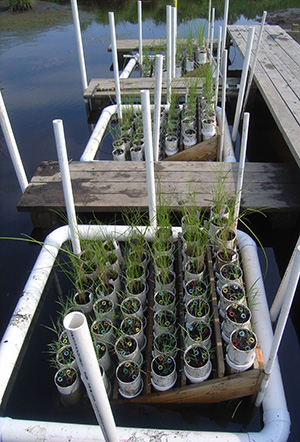
Sea-level rise experiments. Plants in higher cylinders (right) are kept drier, experiencing low sea levels. As they become more submerged (left), they are forced into higher sea levels.
In another reversal, while sedges (C3 plants) grow better under higher CO2, grasses (C4 plants) grow better when nitrogen enters the picture. But a grass-dominated marsh would not bury and store carbon nearly as well as sedge-dominated marsh.
What happens to the marsh as sea level rises?
Sea level rise changes the rules. When it comes to keeping strengthening marshes above sea level, CO2 tends to help and nitrogen tends to hurt. But if the marsh actually starts to flood, Megonigal’s lab discovered a surprise twist: Instead of holding the marsh back, nitrogen actually enhances marsh plants’ ability to build more growth underground.
But the effects only last so long. If the water rises high enough, eventually it overpowers everything else in the marsh. Furthermore, once water levels reach the marsh, the plants most helped by nitrogen are sedges, like Schoenoplectus americanus. But above sea level, those sedges are the same plants that do less well with higher nitrogen. Counting on nitrogen to save our wetlands is a risky proposition. Left unchecked, nitrogen could favor a weaker, grass-covered marsh. By the time sea levels rise high enough to trigger a reversal, it may be too late.
One thing is certain: No marsh can survive underwater. While CO2 and sometimes nitrogen can help, the safest strategy may be to hold climate change in check and keep sea level rise from encroaching on our wetlands in the first place.
Learn more about wetlands and climate change at the Biogeochemistry Lab.

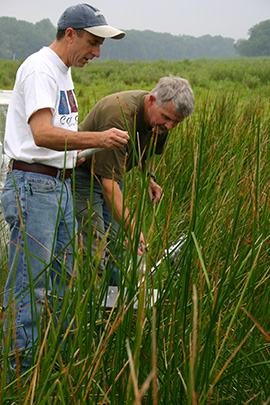
 Discover your
Discover your 